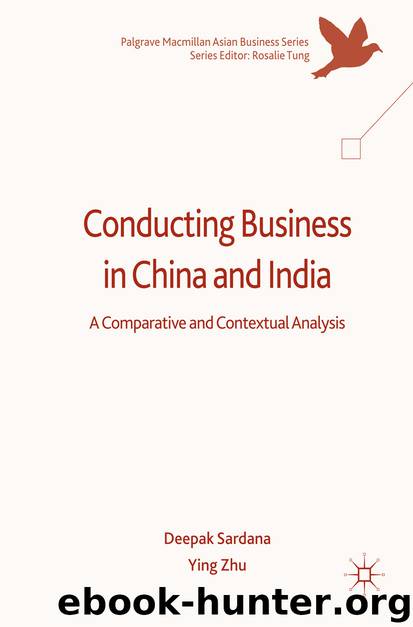Conducting Business in China and India by Deepak Sardana & Ying Zhu

Author:Deepak Sardana & Ying Zhu
Language: eng
Format: epub
Publisher: Palgrave Macmillan UK, London
Concluding Remarks
The look and appeal of the institutional context of China may be significantly different to that of India, but it is not difficult to picture some similarities between the two countries, particularly with reference to the presence of institutional voids that exist within the systems at various levels. These institutional voids have existed in China and India due to loopholes and shortcomings that exist in organization structure, policy making, and implementation of the policies (as discussed extensively in this chapter). This also leads to inefficiency and corruption , which is a common and recurring theme in both China and India. The business-political nexus has also been highlighted as one of the causes of corruption and will be discussed further in Chap. 5.
The lack of transparency in policy formulation and implementation is another aspect that is commonly seen in China and India; this is the cause as well as outcome of institutional voids that exist in the system.
It is, indeed, perplexing that such similar sorts of deficiency are observed in two countries, China and India, having very different institutional contexts . While China follows single-party authoritarian rule, India is a vibrant democracy with a multi-party system . The observed similarities in institutional deficiencies thus affirm the belief that the structure of meso-level institutes and micro-level policies holds as much importance in making a system successful as the macro-level construct of the system. If there are fault lines in the meso-level and micro-level, the outcome is bound to be less than optimal. For example, while vertical authority seems to be a norm in both China and India in matters relating to grassroots democracy at village level , the grass-root situation seems somewhat better in China because of the “decisive intervention by the central government ” (Mohanty et al. 2006, p. 47). However , neither system empowers villagers sufficiently.
This is not to suggest that the macro-level system does not have any imprint on the outcome. For example, whereas democracy and freedom of speech and expression in India have led to a thriving and open discussion on various issues on social media platforms, the result on this front in China is very different. Likewise, while infrastructure development and bold policy making have suffered in India due to democracy and dissent in thought that is due to the multi-party system , China has been able to take several bold policy decisions (whether good or bad is a matter of debate) due to continuity in the government and single-party rule.
China and India are also different institutionally, when it comes to ways of tackling corruption. While technically, India has created autonomous institutions to investigate and oversee corruption cases, most of the institutions in China are internal to the party or controlled by the party. Having said that, we have highlighted how autonomy of the institutes investigating corruption cases is compromised by the party that is ruling at the Federal level in India.
China and India are, however, truly different when it comes to the judiciary . In
Download
This site does not store any files on its server. We only index and link to content provided by other sites. Please contact the content providers to delete copyright contents if any and email us, we'll remove relevant links or contents immediately.
The Brazilian Economy since the Great Financial Crisis of 20072008 by Philip Arestis Carolina Troncoso Baltar & Daniela Magalhães Prates(117381)
International Integration of the Brazilian Economy by Elias C. Grivoyannis(87207)
The Art of Coaching by Elena Aguilar(52864)
Flexible Working by Dale Gemma;(23238)
How to Stop Living Paycheck to Paycheck by Avery Breyer(19613)
The Acquirer's Multiple: How the Billionaire Contrarians of Deep Value Beat the Market by Tobias Carlisle(12203)
Thinking, Fast and Slow by Kahneman Daniel(12004)
The Radium Girls by Kate Moore(11886)
The Art of Thinking Clearly by Rolf Dobelli(10166)
Hit Refresh by Satya Nadella(9009)
The Compound Effect by Darren Hardy(8756)
Tools of Titans by Timothy Ferriss(8176)
Atomic Habits: Tiny Changes, Remarkable Results by James Clear(8139)
Turbulence by E. J. Noyes(7913)
Change Your Questions, Change Your Life by Marilee Adams(7587)
A Court of Wings and Ruin by Sarah J. Maas(7585)
Nudge - Improving Decisions about Health, Wealth, and Happiness by Thaler Sunstein(7494)
How to Be a Bawse: A Guide to Conquering Life by Lilly Singh(7358)
Win Bigly by Scott Adams(7055)
